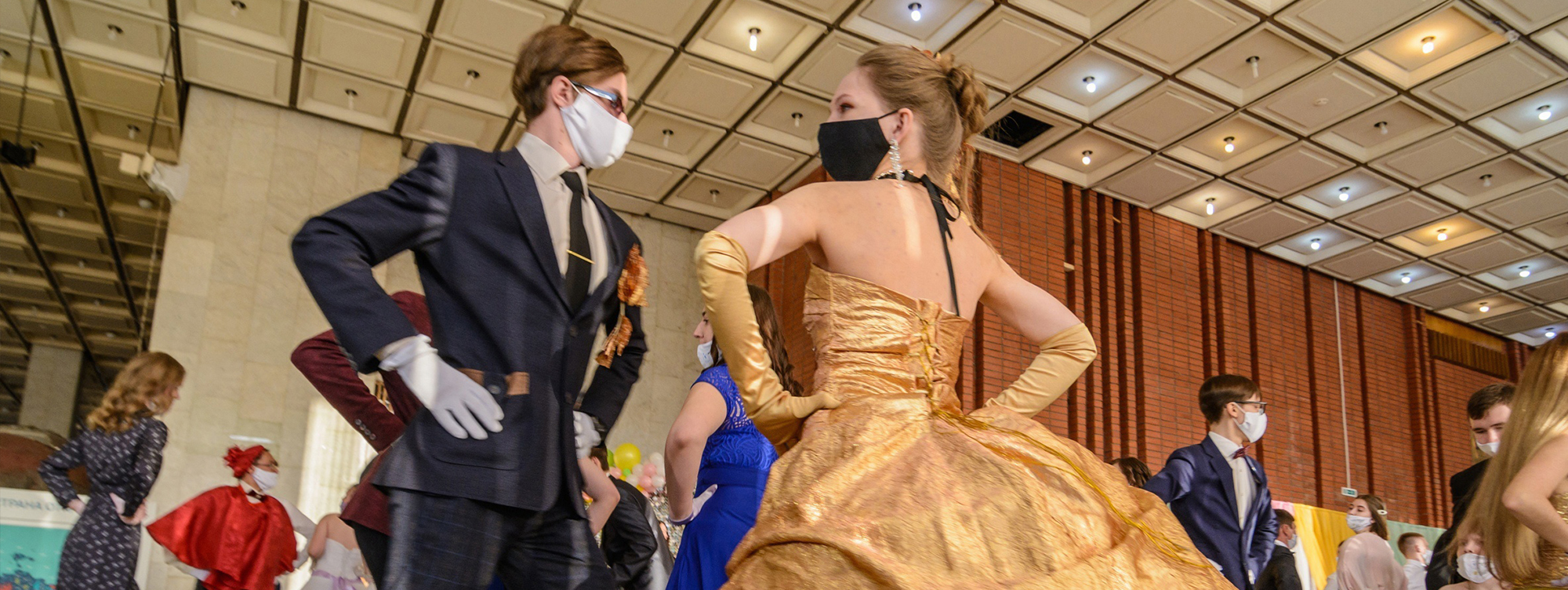One would think: the time of all these ballroom dances — slow waltz, fast quadrille and polka — has long past. However, no girl would refuse to get into a fairytale and dance around with beautiful music, in a lush dress. And what if such balls were accessible to all — either for people with visual or hearing impairment or in wheelchairs? That’s not a fairytale. That’s reality. For more than 8 years Samara has been hosting inclusive balls, and everybody is welcome.
This project was named “Inclusive balls of Russia”. Vladimir Vaskevich, a reporter for “Special view” web-portal, talked to the sponsors of the project, choreographers and participants.
Balls for everyone
The concept of inclusive balls appeared in Samara in 2014 as a result of partnership between Alexey Trantsev, the director of the Inclusive Resource Center, Ekaterina Sizova, the leader of the Studio of Inclusive Arts, and Sergey Boldurev, a ballroom dance choreographer.
That time Alexey was in charge of developing inclusive practices for the youth in regions, aiming not at providing help to a person with disability, but at organizing cooperative activities between the youth with disabilities and without, focused on a specific visible result. The idea of ballroom dances fit perfectly: it was beautiful, spectacular, massive.
“Our first inclusive ball was an experiment, as we had little understanding of how to adapt the ballroom dances to the needs of people with mobility impairments, in wheelchairs and with mental disabilities. These were our first focus groups in our balls. To be honest, the first rehearsal with around 30 participants was pretty much shocking, but it did not discourage Alexey, Ekaterina and Sergey. Their expertise helped: Sergey studied in an international school of ballroom dances and by that time had choreographed dances across the whole country, while Alexey and Ekaterina knew well how to deal with people with various disabilities. We breathed out after this first trial and went on”, Lidia Vanukova, the manager of “Inclusive balls of Russia” project, tells.
After a while the organizers saw certain results: everybody could move around the hall, learnt to hear the music and the rhythm, but above all — got fascinated by the process so much, that were ready to come to rehearsals several times a week. The organizers became sure, that it was indeed possible to adapt the ballroom dances.
“After our first ball the participants seemed to be very excited about the event. Then one of them asked, when the next ball would happen. There could be no doubt anymore — this inclusive practice would stay and evolve”, Lidia Vanukova tells.
Making the ball inclusive
As the number of people willing to participate in the balls started to grow, the sponsors faced new challenges: it was necessary to find a place that could accommodate around 100 people dancing simultaneously.
“Each inclusive ball is a beautiful fairytale and a grand event, that adorns our city. It is especially pleasing to watch the girls’ dreams coming true, as every one of them desires to wear a lush dress, dance around and feel like a queen in the ball. In order for a fairytale to become reality, the sponsors have to do a lot before the ball. While the participants rehearse new dances, we search for the venues and negotiate them, sometimes we have to bring our own equipment to make the venue accessible. In parallel we cooperate a lot with volunteers. For them preparations start long before any dances, since a volunteer has to not only help with preparations, but as well learn how to communicate with any participant of the event, no matter which disabilities or impairments this participant has”, tells Viktor Timakov, a member of Inclusive Resource Center and the organizer of inclusive balls.
2 balls are held in Samara every year. As part of preparations, the sponsors recruit volunteers and provide them with trainings on inclusive interaction with people in wheelchairs, visual and hearing impairments, with mental disorders. During the event the volunteers not only help with its organization, but take part in dances, with that becoming an integral part of the ball.
Soon that bright and unusual event attracted more partners. The organizers found those who helped with rental of dresses for women and suits for men. The project was supported by the Presidential Grants Foundation and a number of companies, among them — Sberbank.
“Our initial goal was to make this event accessible for everybody. At first, we had doubts if this was possible, then,
Dancing without seeing
Once the organizers got the request to let blind people participate as well, they immediately took care about it.
“As time passed, we identified the main difference between our inclusive dances and normal ballroom ones — we avoided changing dance partners during the ball. All ladies and cavaliers get to know their partners in advance — for this we try to create the most balanced pairs in height and combination of their impairments and abilities. However, if they wish to dance with someone else, we will never argue”, says Daniil Kitsaev, the choreographer for the “Inclusive balls of Russia” project.
Such an approach turned out to be highly relevant for the blind participants. During rehearsals, the pairs have to train dance element so well that partners could feel each other, no matter if one of them might not be able to see. In a dance the one who has no visual impairments, even if he/she appears to be in a wheelchair, will lead and, if needed, will give voice commands to help a sightless lady or a cavalier navigate.
“It always takes longer to train a pair with a sightless dancer and requires an individual approach. We try to invite our most experienced dances into such pairs. They and choreographers show the movements to the visually impaired dancer, stand into dancing poses, if needed, and let the sightless person touch them to understand the position of the arms and legs, the body tilt angle, the dynamics of the movement, etc. In the beginning, the sighted partner provides voice commands while moving, to let the sightless partner realize what is happening around, and even counts the rhythm of the dance, since the rhythm of the music and the dancers might not coincide, and you have to move with the flow and perform dance elements at the same time”, Daniil Kitsaev shares.
The acquaintance with the ballroom dances starts from slow waltz, as it is the simplest one to learn. Polonaise and polka are as well part of the curriculum, then tango, figured waltz and more complex dances.
“During our sightless dancers’ trainings, we came across a challenge: it was hard for a sightless person to capture the beauty of the movement. For instance, with Arina (a participant with visual impairments) we worked a lot on such element as raising hands — when they fly up like bird’s wings. For a long time, we got something like a robotic aircraft. Then we faced difficulties with the elegance of the bow, but lots of trainings and Arina’s persistence finally paid off. Now she is a permanent participant of all recent balls”, tells Ilya Ivochkin, the administrator of inclusive balls.
Ilya came into this inclusive project as a volunteer. There are people with disabilities in his family, and he was keen to understand deeper the power of inclusion and nuances of interaction with participants with different types of disabilities. The dance became the perfect tool for this. With time, Ilya has got the honor to deal with those beginners, who demanded the biggest attention. In 1 year, he became the best volunteer for inclusive balls and was invited to join the team of organizers.
“I was very lucky to dance with such partner as Ilya, as by that time he had got experience in several balls. At first, I felt very awkward and thought I would step on everybody’s feet, but the magical atmosphere of dance, mutual understanding and trust at the rehearsal spot did its job. I began to take it easy and got better and better with various elements. I even offered my advice to choreographers, on how to better train the blind. In all dance movements, when I moved alone, I asked everybody to say ‘I am here’, in order to easily identify where everybody stands and come right to my partner. When we move in columns (ladies in one column and cavaliers — in another), the girls are already aware, that I cannot see, and they correct my movements with a slight touch, if I tend to get out of the column”, tells Arina, a ball participant with visual impairments.
The sponsors highlight as well, that balls are not only for the dances. It Is about communication etiquette, the skill of paying each other compliments, making new friends. During the festival each participant learns to be gallant and communicate well with others.
“Sergey Boldurev created this event for everybody to get their chance to walk out of the room, a chance to get into the company of the peers. He used to say ‘We do all that to make a fairy tale come true, for one evening’. Sergey passed away last year, that was a terrible blow for all of us. But the beautiful balls stayed, he had put his whole being into their success, and with our common effort they will continue to evolve. We want this fairy tale to happen as often as possible, for even more people from different regions of Russia”, Lidia Vanukova says. In memory of Sergey Boldurev the organizers introduced a dance, named in his honor.
Inclusive balls to every city
The organizers mention, that the idea of inclusive balls is not something unique. However, in Samara this initiative turned into regular project and became massive. Since 2014 there have been 14 balls held in Samara, with more than 1 thousand participants from 50 regions of Russia.
“We try to respect the main principles of inclusion: people with disabilities account for about one third of all the participants, while all the dancers train together as peers to get to end result and to turn the ball into an event worth remembering for the whole life. We don’t give any excuses to anyone; however, we haven’t yet met those who have failed in every attempt. Everybody gets to his/her first ball. Then some people stop and some dance with us for several years already”, Viktor Timakov tells.
To share experience, the sponsors started to invite participants from other regions. For the period of rehearsals, they were offered hotel accommodation and meals. Samara attracted participants from different cities — from Kaliningrad to Ussuriysk.
“For several years we have welcomed participants from more than 50 regions of Russia, and everybody stayed impressed by the magic of inclusive ball. They went back home inspired, and then asked us about the next ball. That moment we had to admit, that in a while Samara would not be able to cope with all the people willing to participate and we would need to start scaling the project to other regions”, Lidia Vanukova explains.
The employees of the Inclusive Resource Center trained future organizers on their sites and went to other regions, if this was needed. Inclusive balls were held in Yaroslavl, Vologda and other regions. The idea of the inclusive ball turned into ‘social franchise’, which started to spread across Russia.
“Last year we got an idea to organize several balls at once across the whole country. We wanted people to dance together in Volga region, in Siberia and other regions. That was the moment when the ‘Inclusive balls of Russia’ project was born, and it was supported by the Presidential Fund of Cultural Initiatives. Currently we actively cooperate with different partners in various cities, organize on-site trainings and master classes by our choreographers, so that on December 2, 2022, the largest inclusive ball event goes live in our country for the first time”, Lidia Vanukova says.


